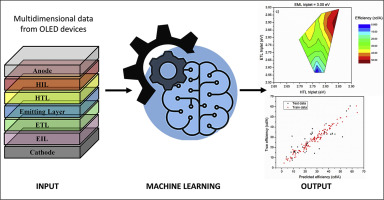Organic Electronics ( IF 2.7 ) Pub Date : 2018-09-25 , DOI: 10.1016/j.orgel.2018.09.029 Muhammad Asyraf Bin Janai , Kai Lin Woon , Chee Seng Chan

|
Recent advances in machine learning have allowed us to quantify the parameters that are important for the fabrication of high efficient phosphorescent bottom emitting organic light emitting diodes (PhOLEDs). Herein, we have collected 304 blue PhOLED data from the literature along with their frontier molecular orbital energy levels, triplet energies, efficiencies, device structures and layer thicknesses. Using these descriptors as the inputs and efficiency as the output, we showed that the random forest algorithm (a machine learning approach) provides significant improved predictive performance over linear regression analysis and other multivariate regression models such as extreme gradient boosting, adaptive boosting, gradient boosting and k-nearest neighbor. The triplet energy of the electron transporting layer was found to be the more critical feature. Complex correlations between various parameters on device efficiency generated by the random forest model are also presented. This study demonstrates the applicability of machine learning algorithm in extracting underlying complex correlations in blue PhOLEDs.
中文翻译:

通过机器学习方法设计高效的蓝色磷光底发射发光二极管
机器学习的最新进展已使我们能够量化对于制造高效磷光底发射有机发光二极管(PhOLED)至关重要的参数。本文中,我们从文献中收集了304种蓝色PhOLED数据,以及它们的前沿分子轨道能级,三重态能量,效率,器件结构和层厚度。使用这些描述符作为输入,并以效率作为输出,我们证明了随机森林算法(一种机器学习方法)相对于线性回归分析和其他多元回归模型(例如极端梯度增强,自适应增强,梯度增强)提供了显着改善的预测性能和k最近的邻居。发现电子传输层的三重态能量是更关键的特征。还介绍了随机森林模型生成的设备效率的各种参数之间的复杂相关性。这项研究证明了机器学习算法在提取蓝色PhOLED中潜在的复杂相关性方面的适用性。











































 京公网安备 11010802027423号
京公网安备 11010802027423号